
/|\
“Where they have burned books, they will end in burning human beings.”
Wednesday, March 29, 2006
This Better Be On Every Front Page
While the world wets itself over Iran's nuclear ambitions, Forbes reports that Saudi Arabia wants the bomb, too. And they're employing Pakistani scientists to get it.
Yes. Saudi Arabia. You know, that country with the oil, the crazy fundamentalists, the tyrant kings. No, not Texas, Saudi Arabia. The country that brought us 15 out of the 19 hijackers on 9/11. The country that lies about how much oil it has. The country that Bush's family has a significant history of deals with.
And yet--watch. How many people will react to this threat? How many people will even know about this threat? And when it happens, will the Saudis join the axis of evil, or will Bush once again make an exception, despite the fact that this is a country that deeply hates us and is in danger of falling to radical Islamic fundamentalists?
|
posted by Mary, 8:20 PM
Nothing of him that doth fade,
But doth suffer a sea-change
Into something rich and strange.
Time has the melting ice sheets on its cover this week. Scary stuff, of course. (You have to sit through an ad, but read it anyway.)
What few people reckoned on was that global climate systems are booby-trapped with tipping points and feedback loops, thresholds past which the slow creep of environmental decay gives way to sudden and self-perpetuating collapse. Pump enough CO2 into the sky, and that last part per million of greenhouse gas behaves like the 212th degree Fahrenheit that turns a pot of hot water into a plume of billowing steam. Melt enough Greenland ice, and you reach the point at which you're not simply dripping meltwater into the sea but dumping whole glaciers. By one recent measure, several Greenland ice sheets have doubled their rate of slide, and just last week the journal Science published a study suggesting that by the end of the century, the world could be locked in to an eventual rise in sea levels of as much as 20 ft. Nature, it seems, has finally got a bellyful of us.
"Things are happening a lot faster than anyone predicted," says Bill Chameides, chief scientist for the advocacy group Environmental Defense and a former professor of atmospheric chemistry. "The last 12 months have been alarming." Adds Ruth Curry of the Woods Hole Oceanographic Institution in Massachusetts: "The ripple through the scientific community is palpable."
[snip]
It's at the North and South poles that those steambath conditions are felt particularly acutely, with glaciers and ice caps crumbling to slush. Once the thaw begins, a number of mechanisms kick in to keep it going. Greenland is a vivid example. Late last year, glaciologist Eric Rignot of the Jet Propulsion Laboratory in Pasadena, Calif., and Pannir Kanagaratnam, a research assistant professor at the University of Kansas, analyzed data from Canadian and European satellites and found that Greenland ice is not just melting but doing so more than twice as fast, with 53 cu. mi. draining away into the sea last year alone, compared with 22 cu. mi. in 1996. A cubic mile of water is about five times the amount Los Angeles uses in a year.
Dumping that much water into the ocean is a very dangerous thing. Icebergs don't raise sea levels when they melt because they're floating, which means they have displaced all the water they're ever going to. But ice on land, like Greenland's, is a different matter. Pour that into oceans that are already rising (because warm water expands), and you deluge shorelines. By some estimates, the entire Greenland ice sheet would be enough to raise global sea levels 23 ft., swallowing up large parts of coastal Florida and most of Bangladesh. The Antarctic holds enough ice to raise sea levels more than 215 ft.
Will that happen? I don't know. But according to CNN, "'There will be no polar ice by 2060,' says Larry Schweiger, president of the National Wildlife Federation."
So let's play a game of "let's pretend." What if the waters began to rise? What if they rose 3ft (1m)? Or 20ft (about 6m)?
The Department of Geosciences at the University of Arizona has set up an interesting simulation of coastlines depending on how much the sea levels rise. Using that, I made some maps of the area I live in--i.e. the Delaware Valley--of what the coastline would look like if the levels rose: at best 1 meter, worse 6 meters. The worst is if one of the Antarctic shelves were to melt, but I don't know how likely that actually is.
Click on the thumb nail to see a larger image:
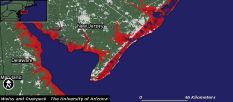
South Jersey, 1 meter
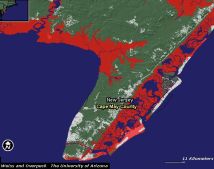
Cape May County, NJ, 1 Meter
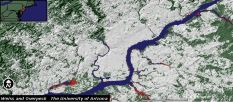
Philadelphia, 1 meter
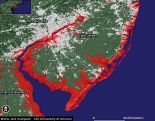
Delaware Valley, 6 meters
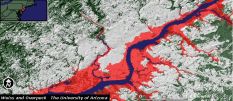
Philadelphia, 6 meters
Hark! now I hear them.
|
posted by Mary, 11:40 AM
Tuesday, March 28, 2006
Never A Discouraging Word
'Cause My Silence Is Assured
The reason for that being that I have a monster headache and I've been battling insomnia, and not the fun kind. But I have a few posts I'm working on, including one with--gasp!--models of an inundated Delaware Valley. You'll see.
|
posted by Mary, 12:50 PM




























